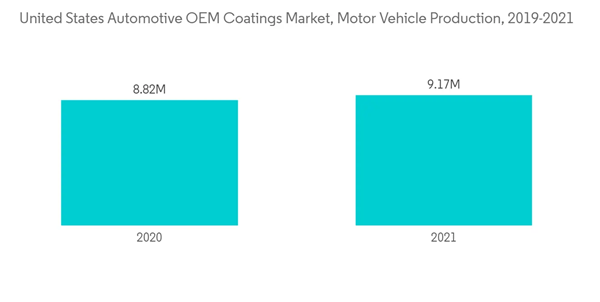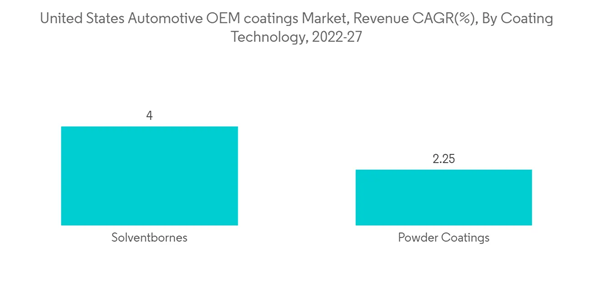Key Highlights
- The US automotive OEM market is estimated to grow during the forecast period owing to technological advancements and changes in automotive vehicle product offerings.
- As governments implement stricter fuel-efficiency rules, there will be an increase in demand for lightweight, fuel-efficient OEM parts. Therefore, to reduce emissions, the growing demand for electric vehicles is expected to provide an opportunity to expand the market in the future.
- On the other hand, supply chain issues such as the shortage of semiconductors have been hindering growth recently.
US Automotive OEM Coatings Market Trends
Public & Private Investments to Support Automotive Industry
- The automobile sector is rapidly changing, and supply chains across the United States have a significant impact. While microchip shortages are gradually improving, they are still expected to continue until at least the second quarter of 2022. However, the industry is expected to recover by 2023.
- Automotive production in the United States declined by 16% in 2021 compared to 2020. To strengthen the industry, the government is taking several initiatives to support the recovery. Several investments have been made to support the automotive OEM sector in the United States.
- With a sustained focus on electric vehicles, a significant shift toward EV production is increasing. With a focus on automobile standards, the government is investing billions in an 'all-electric' future.
- In order to replace fossil fuels with electricity by 2030, the government plans to provide USD 7.5 billion for a network of electric charging stations to be built nationwide.
- The American Automakers Automotive Policy Council aims to boost semiconductor production in the United States through the America COMPETES Act. A total investment of USD 52 billion is planned under the America COMPETES Act to address the semiconductor shortage. Out of which USD 2 billion are specified for semiconductor production specifically for the automotive industry.
- Therefore owing to the above-mentioned investments, the automotive OEM market in the United States is likely to grow in the coming years.
Water-borne Technology is Expected to Grow At The High Rate
- Although solvent-borne technology accounts for most of the market, it is predicted to grow slowly over the forecast period.
- Regulations governing VOC emissions from hazardous air pollutants contained in solvent-borne automotive OEM coatings such as toluene, xylene, ethylbenzene, and methyl ethyl ketone are one of the major factors limiting the expansion of solvent-borne automotive OEM coatings.
- Water-based automotive OEM coatings are becoming increasingly popular due to the continuously changing environmental regulations. Water-based coatings are constantly developing to provide the same performance as solvent-based coatings. For example, mild co-solvent reducers and additives are being developed to improve water-based coatings' performance and drying times.
- The increasing adoption of waterborne automotive coatings is due to their physical and chemical qualities, such as high chemical resistance, low processing temperature, and solvent-free formulations.
- Water-based solutions, such as 2K waterborne, light conductive primer, are commonly used to coat OEM body parts. One of the most notable developments is a thin-film primer based on waterborne technology that is widely employed in the automotive OEM business industry.
- In addition, acrylic PUD water-borne coats are surpassing acrylic MF and polyester MF solvent-borne coatings in the OEM market. They are growing at the highest pace among base coatings.
- Owing to the above-mentioned factors, waterborne technology is expected to grow significantly during the forecast period.
US Automotive OEM Coatings Market Competitor Analysis
The US automotive OEM coatings market is consolidated in nature. Some of the major players in the market include RPM International Inc, AkzoNobel NV, Axalta Coatings Systems, BASF SE, and PPG Industries Inc., among others (in no particular order).Additional benefits of purchasing the report:
- The market estimate (ME) sheet in Excel format
- 3 months of analyst support
This product will be delivered within 2 business days.
Table of Contents
1 INTRODUCTION1.1 Study Assumptions
1.2 Scope of the Study
2 RESEARCH METHODOLOGY
3 EXECUTIVE SUMMARY
4 MARKET DYNAMICS
4.1 Market Overview
4.2 Market Drivers
4.2.1 Government Initiatives to Support Market Growth
4.3 Market Restraints
4.3.1 Ongoing Shortage of Semiconductors
4.3.2 Other Restraints
4.4 Industry Value Chain Analysis
4.5 Porters 5 Force Analysis
4.5.1 Threat of New Entrants
4.5.2 Bargaining Power of Buyers/Consumers
4.5.3 Bargaining Power of Suppliers
4.5.4 Threat of Substitute Products
4.5.5 Intensity of Competitive Rivalry
5 MARKET SEGMENTATION (Market Size in Value)
5.1 Resin Type
5.1.1 Epoxy
5.1.2 Acrylic
5.1.3 Alkyd
5.1.4 Polyurethane
5.1.5 Polyester
5.1.6 Other Resin Type
5.2 Technology
5.2.1 Water-borne
5.2.2 Solvent-borne
5.2.3 Other Technologies
5.3 Application
5.3.1 Passenger Cars
5.3.2 Commercial Vehicles
5.3.3 ACE
6 COMPETITIVE LANDSCAPE
6.1 Mergers and Acquisitions, Joint Ventures, Collaborations, and Agreements
6.2 Market Share (%) **/Ranking Analysis
6.3 Strategies Adopted by Leading Players
6.4 Company Profiles
6.4.1 AkzoNobel NV
6.4.2 Axalta Coatings Systems
6.4.3 Mankiewicz Gebr. & Co.
6.4.4 PPG Industries Inc.
6.4.5 RPM International Inc.
6.4.6 KCC Corporation
6.4.7 Nippon Paint Holdings Co. Ltd.
6.4.8 Beckers Group
6.4.9 BASF SE
6.4.10 Red Spot Paint & Varnish Company, Inc.
6.4.11 Valspar Automotive
6.4.12 The Sherwin Williams
7 MARKET OPPORTUNITIES AND FUTURE TRENDS
7.1 Growing Trend for Electric Vehicles to Reduce Emmissions
Companies Mentioned (Partial List)
A selection of companies mentioned in this report includes, but is not limited to:
- AkzoNobel NV
- Axalta Coatings Systems
- Mankiewicz Gebr. & Co.
- PPG Industries Inc.
- RPM International Inc.
- KCC Corporation
- Nippon Paint Holdings Co., Ltd.
- Beckers Group
- BASF SE
- Red Spot Paint & Varnish Company, Inc.
- Valspar Automotive
- The Sherwin Williams
Methodology

LOADING...










